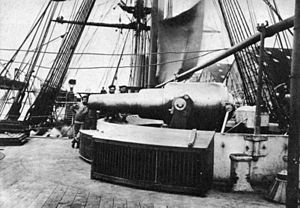RML 11-inch 25-ton gun: Difference between revisions
m Robot - Speedily moving category Victorian Age weapons of Great Britain to Category:Victorian Age weapons of the United Kingdom per CFDS. |
|||
| Line 84: | Line 84: | ||
[[Category:Naval guns of the United Kingdom]] |
[[Category:Naval guns of the United Kingdom]] |
||
[[Category:280 mm artillery]] |
[[Category:280 mm artillery]] |
||
[[Category:Victorian Age weapons of |
[[Category:Victorian Age weapons of the United Kingdom]] |
||
[[de:RML 11-inch-gun]] |
[[de:RML 11-inch-gun]] |
||
Revision as of 10:29, 24 August 2011
| Ordnance RML 11 inch 25 ton gun | |
|---|---|
 Disappearing gun on HMS Temeraire in firing position | |
| Type | Naval gun Coast defence gun |
| Service history | |
| In service | 1867-190? |
| Used by | Royal Navy |
| Wars | Bombardment of Alexandria (1882) |
| Production history | |
| Manufacturer | Royal Arsenal |
| Variants | Mk I, Mk II |
| Specifications | |
| Mass | 25 long tons (25,000 kg) |
| Barrel length | 145 inches (3.7 m) (bore + chamber)[1] |
| Shell | 532 to 543 pounds (241.3 to 246.3 kg) Palliser, Common, Shrapnel |
| Calibre | 11-inch (279.4 mm) |
| Muzzle velocity | 1,360 feet per second (410 m/s)[2] |
RML 11 inch 25 ton guns were large rifled muzzle-loading guns used as primary armament on British battleships and for coastal defence. They were effectively the same gun as the RML 12 inch 25 ton gun, bored to 11 inches instead of 12.
Design

Mark I was introduced in 1867. Mark II was introduced in 1871 using the simpler and cheaper "Fraser" gun construction method which had proved successful with the RML 9 inch 12 ton Mk IV gun. [3]
Naval service
Guns were mounted on :
- HMS Alexandra commissioned 1877
- HMS Temeraire commissioned 1877
Ammunition
The gun's primary projectile was 536 - 543 pound "Palliser" armour-piercing shot, which were fired with a "Battering charge" of 85 pounds of "P" (gunpowder) or 70 pounds of "R.L.G." (gunpowder) for maximum velocity and hence penetrating power. Shrapnel and Common (exploding) shells weighed 532 - 536 pounds and were fired with a "Full charge" of 60 pounds "P" or 50 pounds "R.L.G."[4].
See also
Surviving examples

- A Mark II gun at Fort Nelson, Portsmouth, UK
Notes
- ^ Treatise on Construction of Service Ordnance 1877, page 292
- ^ MV of 1,360 feet/second firing 543-pound 2-oz projectile with "Battering charge" of 85 pounds "P" (gunpowder) is quoted in "Text Book of Gunnery 1887" Table XVI.
- ^ Treatise on Construction of Service Ordnance, 1879, page 281-282
- ^ Treatise on Ammunition 1877, pages 191,194, 205, 220
References
- Treatise on Ammunition. War Office, UK, 1877
- Treatise on the Construction and Manufacture of Ordnance in the British service. War Office, UK, 1877
- Treatise on the Construction and Manufacture of Ordnance in the British Service. War Office, UK, 1879
- Text Book of Gunnery, 1887. LONDON : PRINTED FOR HIS MAJESTY'S STATIONERY OFFICE, BY HARRISON AND SONS, ST. MARTIN'S LANE
